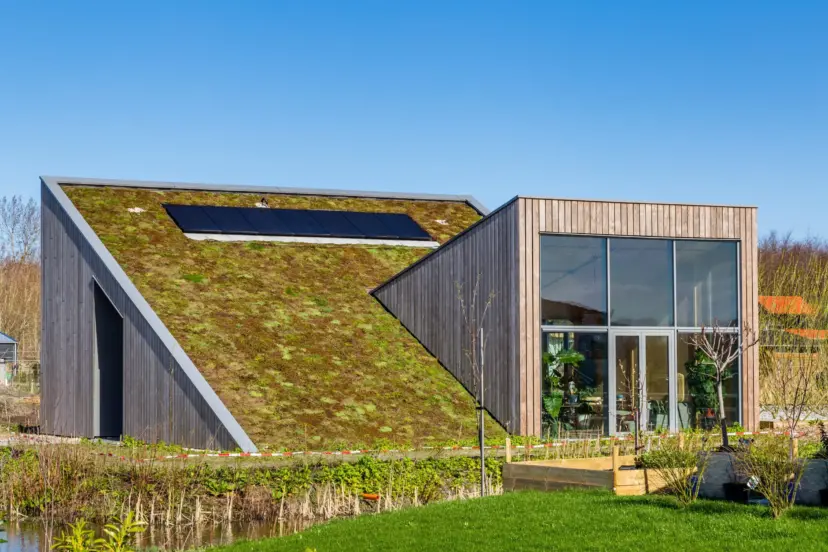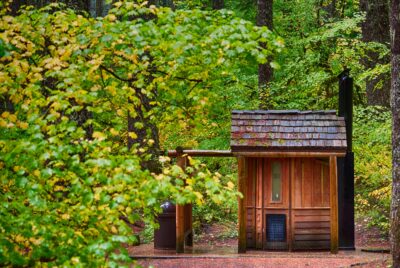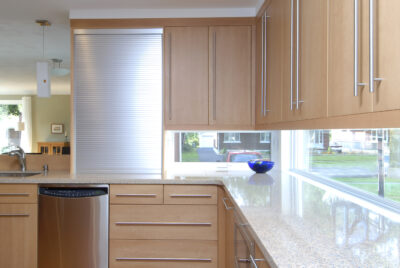10 Sustainable Features Every Tiny Green Home Should Have
Living in a tiny green house transcends mere reduction in size. It represents a profound commitment to sustainable features, where every aspect of daily living is consciously aligned with environmental stewardship. Fostering a deeper connection with our planet involves embracing a lifestyle that minimizes our ecological footprint while prioritizing comfort, efficiency, and well-being.
Whether you’re embarking on the journey of building your own tiny house or seeking to transform an existing space into a haven of sustainability, the integration of sustainable features lies at the heart of this endeavor. These features serve as the building blocks of a healthy, eco-friendly living environment. Every choice, from materials to energy systems, is made with sustainability in mind.
In this comprehensive guide, we’ll delve into ten essential sustainable features that form the cornerstone of every tiny green house. Through practical advice, insights, and inspiration, we aim to empower you to create the green home of your dreams. To create a sanctuary that not only nurtures your soul but also honors our planet. So let’s embark on this journey together. Let’s explore the transformative power of sustainable living. Let’s discover how even the tiniest of homes can make a significant difference in shaping a more sustainable future for generations to come.
1. Energy-Efficient Appliances and Systems
Investing in energy-efficient appliances and systems is one of the most effective ways to reduce energy consumption and lower utility bills in your tiny green house. ENERGY STAR-rated appliances, such as refrigerators, dishwashers, and washing machines, are designed to use less energy while delivering high performance and reliability. Additionally, choosing energy-efficient heating, ventilation, and air conditioning (HVAC) systems can significantly reduce energy usage and improve indoor comfort.
When selecting energy-efficient appliances and systems for your tiny green house, consider factors such as size, capacity, and functionality to meet your specific needs. For instance, opt for smaller appliances that are appropriately sized for your tiny house to avoid wasting energy on unnecessarily large units. Additionally, consider multifunctional appliances that serve multiple purposes, such as combination washer-dryers or convection microwaves, to maximize efficiency and save space.
In terms of HVAC systems, explore options like ductless mini-split heat pumps, which offer efficient heating and cooling without the need for ductwork. These systems use inverter-driven compressors to adjust to the desired temperature gradually, consuming less energy than traditional HVAC systems. Moreover, consider installing programmable or smart thermostats to optimize energy usage based on your schedule and preferences, further enhancing efficiency and comfort.
2. Passive Solar Design
Passive solar design is a cornerstone of sustainable architecture, leveraging the sun’s energy to passively heat, cool, and illuminate buildings. To maximize the benefits of passive solar design in your tiny green house, start by analyzing your site’s solar exposure and microclimate. Orient your house to capture the sun’s rays during the winter months while shading windows and minimizing solar gain in the summer.
Strategically place windows, skylights, and clerestory openings to optimize natural daylighting and ventilation, reducing the need for artificial lighting and mechanical cooling. Consider incorporating thermal mass materials, such as concrete, brick, or tile, into your interior design to absorb and store solar heat during the day, releasing it gradually at night to maintain a comfortable temperature.
Additionally, explore passive solar heating techniques like direct gain, where sunlight enters through south-facing windows and warms interior surfaces, or indirect gain, where sunlight is absorbed by thermal mass and distributed throughout the space via convection currents or radiant heat. By integrating these passive solar design principles into your tiny green house, you’ll enhance energy efficiency, comfort, and sustainability.
3. Efficient Insulation and Air Sealing
Effective insulation and air sealing are critical components of a high-performance building envelope, providing thermal comfort, energy efficiency, and indoor air quality in your tiny green house. When selecting insulation materials, prioritize options with high R-values and low environmental impact, such as recycled cellulose, denim, or wool insulation.
Ensure proper installation and coverage to minimize thermal bridging and thermal bypass, where heat escapes through gaps or voids in the insulation layer. Seal air leaks around windows, doors, electrical outlets, and plumbing penetrations using caulking, weatherstripping, or expanding foam to prevent conditioned air from escaping and outdoor air from infiltrating.
Consider employing advanced air sealing techniques like blower door testing to identify and address hidden air leaks, optimizing energy performance and occupant comfort. Moreover, explore innovative insulation strategies like insulated concrete forms (ICFs), structural insulated panels (SIPs), or straw bale construction, which offer superior thermal performance and durability in a compact footprint.
4. Water-Saving Fixtures and Systems
Conserving water is essential for sustainable living, particularly in arid regions or areas prone to drought. In your tiny green house, prioritize water-saving fixtures and systems to minimize water usage while maintaining convenience and functionality. Install low-flow faucets, aerators, and showerheads that deliver a satisfying flow rate while reducing water consumption by up to 50% compared to conventional fixtures.
Consider upgrading to high-efficiency toilets that use significantly less water per flush than older models without sacrificing performance. Alternatively, explore composting toilets or incinerating toilets that eliminate the need for water altogether, converting human waste into safe and odorless compost or ash.
Implement greywater recycling systems to capture and treat wastewater from sinks, showers, and laundry for reuse in irrigation or toilet flushing, reducing freshwater demand and wastewater discharge. Additionally, harvest rainwater from your roof using gutters and downspouts connected to storage tanks, providing a supplemental water source for landscaping, gardening, or household use.
5. Renewable Energy Sources
Harnessing renewable energy sources is a cornerstone of sustainable living, offering clean, abundant, and renewable alternatives to fossil fuels in your tiny green house. Solar power, wind energy, and hydropower are viable options for generating electricity on-site, reducing reliance on grid power and lowering carbon emissions.
Solar photovoltaic (PV) panels are the most common and accessible renewable energy technology, converting sunlight into electricity using semiconductor materials. Install solar panels on your roof or property to capture solar energy throughout the day, generating electricity to power your lights, appliances, and electronics.
Consider incorporating solar water heating systems, which use solar collectors to heat water for domestic use or space heating, further reducing energy consumption and utility costs. Explore opportunities for small-scale wind turbines or micro-hydro systems if your site has sufficient wind or water resources, providing additional renewable energy generation capacity.
6. Green Roof and Living Walls
Green roofs and living walls are innovative green building techniques that offer numerous environmental, aesthetic, and functional benefits in your tiny green house. They are also known as vegetated roofs or eco-roofs, consist of a layer of vegetation, soil, and drainage on top of a waterproofing membrane, providing insulation, stormwater management, and habitat creation.
Install a green roof on your tiny house to reduce heat gain, improve air quality, and mitigate urban heat island effects, creating a biodiverse ecosystem that supports pollinators, birds, and beneficial insects. Choose drought-tolerant plants native to your region, such as sedum, grasses, and wildflowers, that require minimal maintenance and irrigation once established.
Living walls, or vertical gardens, are vertical structures covered in vegetation that provide similar benefits to green roofs in a smaller footprint. Install these walls on exterior or interior surfaces of your tiny green house to enhance air quality, reduce noise pollution, and create a striking visual focal point. Choose plants with varying textures, colors, and growth habits to create a living work of art that transforms with the seasons.
Both green roofs and living walls require careful planning and design to ensure structural integrity, proper drainage, and plant selection. Consult with a green building professional or landscape architect to assess feasibility, select appropriate materials, and implement maintenance protocols for long-term success.
7. Recycled and Upcycled Materials
Embracing recycled and upcycled materials in your tiny green house construction is a sustainable and cost-effective way to reduce waste and environmental impact while adding character and charm to your space. From reclaimed wood and salvaged fixtures to recycled glass and metal, repurposing materials diverts waste from landfills and conserves natural resources.
Source reclaimed materials from local salvage yards, demolition sites, or online marketplaces to find unique and affordable building materials with a rich history and patina. Look for opportunities to upcycle discarded items like shipping containers, pallets, or tires into functional elements of your tiny house, such as exterior cladding, furniture, or landscaping features.
Consider the environmental and health impacts of materials when selecting recycled or upcycled options for your tiny green house. Choose products with low VOC (volatile organic compound) emissions, formaldehyde-free adhesives, and non-toxic finishes to promote indoor air quality and occupant health
8. Composting Toilet and Greywater System
Installing a composting toilet and greywater system in your tiny green house is a sustainable alternative to conventional sewage systems, reducing water consumption and wastewater discharge while producing valuable resources for soil fertility and plant growth. Composting toilets use aerobic decomposition to break down human waste into nutrient-rich compost, which can be safely returned to the soil as a natural fertilizer.
Choose a composting toilet system that suits your space, budget, and lifestyle, whether it’s a self-contained unit for indoor use or a remote composting chamber for outdoor installation. Follow manufacturer guidelines for maintenance and operation to ensure proper composting and odor control, adding bulking agents like sawdust or coconut coir as needed to facilitate decomposition.
Greywater systems capture and treat wastewater from sinks, showers, and laundry for reuse in irrigation or toilet flushing, reducing freshwater demand and wastewater discharge. Install a simple greywater diverter or a more sophisticated treatment system based on your site conditions and regulatory requirements, ensuring compliance with local codes and ordinances.
9. Natural Ventilation and Cooling Strategies
Promoting natural ventilation and cooling in your tiny green house is essential for maintaining indoor comfort, air quality, and energy efficiency year-round. Design your tiny house with operable windows, skylights, and clerestory openings to facilitate cross-ventilation and passive cooling, allowing fresh air to circulate freely and exhaust warm air during the summer months.
Install ceiling fans, awnings, and shading devices to reduce solar heat gain and enhance airflow throughout your tiny house. Choose energy-efficient fans with adjustable speeds and reversible motors to optimize comfort and energy savings in different seasons and climates.
Explore passive cooling techniques such as earth-sheltered construction, thermal mass, and evaporative cooling to further enhance comfort and reduce reliance on mechanical cooling systems. Incorporate design elements like trellises, pergolas, and breezeways to create shaded outdoor spaces that promote natural ventilation and passive cooling in your tiny green house.
10. Eco-Friendly Landscaping and Outdoor Spaces
Transforming your outdoor spaces with eco-friendly landscaping and design enhances the beauty, functionality, and sustainability of your tiny green house property while promoting biodiversity, conserving resources, and mitigating environmental impacts. Choose native plants that are adapted to your region’s climate, soil, and rainfall patterns, requiring minimal water, fertilizer, and maintenance to thrive.
Create diverse habitats for native wildlife by incorporating features like bird feeders, bat houses, butterfly gardens, and pollinator-friendly plants into your landscape design. Install permeable hardscapes such as gravel pathways, pervious pavers, or decomposed granite patios to reduce stormwater runoff, replenish groundwater, and prevent erosion.
Design outdoor living areas that encourage connection with nature and promote relaxation, recreation, and socialization in your tiny green house property. Incorporate elements like edible gardens, outdoor kitchens, fire pits, and seating areas that reflect your lifestyle, preferences, and values while fostering a deeper appreciation for the natural world.
Conclusion
Creating a sustainable tiny green house is more than just reducing environmental impact; it’s a commitment to enhancing life and living in harmony with nature. Integrating sustainable features into your design not only creates a healthier home but also contributes significantly to the planet’s well-being. From energy-efficient appliances to renewable energy sources, each feature minimizes resource consumption and reflects your values as a steward of the Earth.
These sustainable elements play a crucial role in reducing waste and minimizing your tiny green house’s environmental footprint. Energy-efficient appliances and passive solar design enhance comfort and reduce utility bills, while water-saving fixtures conserve precious resources. Additionally, the integration of renewable energy sources like solar power further decreases reliance on non-renewable energy, promoting a greener lifestyle.
By embracing sustainability in your housing choices, you set an example for others and inspire positive change. Sharing experiences, educating others, and advocating for policy changes contribute to a more sustainable future for all. Building a tiny green house isn’t just about creating a structure; it’s about building a legacy of stewardship and resilience. Together, let’s continue to build a brighter, greener future—one tiny green house at a time.
FAQs about Sustainable Features In Tiny Green Houses
1. Can I incorporate sustainable features into my existing tiny house?
Yes, many sustainable features can be retrofit into existing tiny houses, such as energy-efficient appliances, insulation upgrades, solar systems, green walls and water-saving fixtures. Many cities have incentives to upgrade your home to be more energy efficient. Check with your local government,
2. How much does it cost to implement these sustainable features?
The cost of incorporating sustainable features varies depending on factors such as the size of your tiny house, the complexity of the features, and the materials used. However, many sustainable features offer long-term cost savings through reduced utility bills and maintenance costs.
3. Are there any zoning or building code restrictions for adding sustainable features into tiny green houses?
Zoning and building code regulations for tiny houses vary by location, so it’s essential to research local ordinances and obtain necessary permits before building or modifying a tiny green house.
4. What are the environmental benefits of living in a tiny green house?
Living in a tiny green house reduces environmental impact by minimizing resource consumption, energy usage, and waste generation. Additionally, sustainable features such as renewable energy systems and green infrastructure contribute to biodiversity and ecosystem health.
5. How can I learn more about sustainable tiny house living?
There are many resources available, including books like ‘Projects-Building-Backyard-Homestead-Hands‘ on Amazon, websites, workshops, forums and communities dedicated to sustainable tiny house living. Explore these resources, connect with like-minded individuals, and continue learning and growing on your sustainable living journey.




